- 6 Hot And In-Demand Tech Areas In 2024
- How To Forward Your Career With Cloud Skills?
- Top 7 On-Demand IT Certifications
- Most In-demand Technologies To Upskill Your Career
- Top 10 Hottest Tech Skills to Master in 2024
- Top Skills You Need to Become a Data Scientist
- Groovy Interview Questions
- Facets Interview Questions
- Crystal Reports Tutorial
- VAPT Interview Questions
- Flutter Tutorial
- Saviynt VS Sailpoint
- Flutter vs Xamarin
- PingFederate Interview Questions and Answers
- Dart vs Javascript : What's the Difference?
- Terraform Private Registry
- Cylance Interview Questions and Answers
- Sophos Interview Questions and Answers
- Top Camunda Interview Questions
- NUnit Interview Questions and Answers
- Impala Interview Questions and Answers
- ETL Tutorial
- Ionic Interview Questions
- Grafana Tutorial
- What is VAPT? - A Complete Beginners Tutorial
- SnapLogic Interview Questions
- Saviynt Interview Questions
- What is PingFederate? - A Complete Beginners Tutorial
- SnapLogic Tutorial
- Grafana Interview Questions
- RHCE Interview Questions and Answers
- Domo Interview Questions and Answers
- Terraform Interview Questions
- What is Sophos? | Sophos Turorial for Beginners
- Top Servlet Interview Question And Answers
- NLP Interview Questions and Answers
- Microsoft Intune Interview Questions
- Top XML Interview Questions And Answers
- Tosca Commander
- Katalon vs Cypress
- SQLite Tutorial
- Tosca Tutorial - A Complete Guide for Beginners
- Xamarin Interview Questions and Answers
- UiPath vs Automation Anywhere - The Key Differences
- OpenShift Interview Questions
- What is Katalon Studio - Complete Tutorial Guide
- Kronos Interview Questions
- Tosca Framework
- Burp Suite Tutorial
- Mendix Interview Questions
- Power Platform Interview Questions
- Burp Suite Interview Questions
- What is Mendix
- What is Terraform ?
- Burp Suite Alternatives
- Dart vs Kotlin
- What is Kronos?
- ES6 Interview Questions
- Entity Framework Interview Questions
- COBOL Interview Questions
- Express JS Interview Questions
- OSPF Interview Questions
- LINQ Tutorial
- CSS3 Interview Questions and Answers
- Auth0 Tutorial
- MS Access Interview Questions
- What is SPARQL - A Complete Tutorial Guide
- ExpressJS Tutorial
- UML Tutorial
- HTML vs XML
- Cypress vs Jest
- Impacts of Social Media
- OWASP Interview Questions
- Security Testing Interview Questions
- OpenShift vs Docker
- ES6 Tutorial
- Spark SQL Interview Questions
- Spark SQL Tutorial
- What is OWASP?
- AppDynamics Interview Questions
- Dynatrace Interview Questions
- Rest Assured Tutorial
- New Relic Interview Questions
- REST API Tutorial
- Datadog Interview Questions
- Rest API Interview Questions
- Rest Assured Interview Questions
- PTC Windchill Interview Questions
- Easiest Tech Skills To Learn
- Python SQLite Tutorial - How to Install SQLite
- Datadog Tutorial - Datadog Incident Management
- What is AppDynamics - AppDynamics Architecture
- RabbitMQ Interview Questions And Answers
- What is Dynatrace
- Datadog Vs Splunk
- Web Developer Job Description
- JP Morgan Interview Questions
- Types of Corporate Training
- Benefits of Corporate Training
- What is Corporate Restructuring?
- Blended Learning in Corporate Training
- What is Corporate Level Strategy?
- Flutter Projects and Use Cases
- How to Become a Web Developer
- How To Install Keras?
- How to Install Flutter on Windows?
- How to Install Cypress on Windows?
- How to Become a Computer Scientist?
- How to Install Katalon Studio in Windows
- How to Become a Programmer
- OWASP Projects and Use Cases
- How to Install Sophos?
- Workato Tutorial
- Workato Tutorial - What is Workato?
Web services are one of the most important components of the programmable Web since they allow two programs to converse and share useful information over the same network. For web developers, it has become a necessary component of development.
We have categorized Web Services Interview Questions - 2023 (Updated) into 3 levels they are:
| Table of Content - Web Services Interview Questions |
Frequently Asked Web Services Interview Questions
- What are the essential features of Web Services?
- What are the different components of Web Services?
- How does a Web Service work?
- What is WSDL?
- Write the difference between API and Web Services.
- What is XML-RPC?
- Explain Web Service Architecture
- What are the different layers of the Web Service protocol stack?
- What are the different elements of the SOAP Document or message?
- Name some essential deploy annotations of JAX-WS.
Web Services Interview Questions and Answers For Freshers
If you are a fresher, these Web service interview questions will help you to crack your interview
1. What do you mean by Web Service?
Web services are just a software system specifically built to disseminate communication between client and server applications on the World Wide Web, as the name implies (World Wide Web). In simple terms, it is a network communication method that allows two or more devices to communicate. It enables several programmes written in various programming languages to easily communicate with one another. It will allow you to expose business logic through API and use the internet for direct application-to-application interaction.

| If you want to enrich your career and become a professional in Web Services, then enroll in "SoapUI Training". This course will help you to achieve excellence in this domain. |
2. Explain different types of Web Services
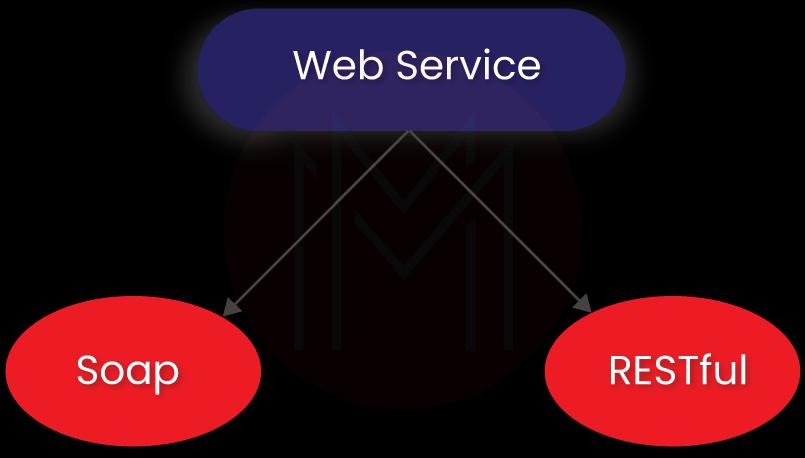
- Simple Object Access Protocol (SOAP) Web Services: It is also known as a transport-independent messaging protocol, and it is based on the XML protocol. Its main goal is to convey a message.
- Representational State Transfer (RESTful) Web Services: It was created to address the inadequacies of SOAP and improve web services’ effectiveness.
3. What are the essential features of Web services?
The following are some of the most important characteristics of web services:
- Used in an XML messaging system that is standardized.
- There is no requirement to use a specific programming language or operating system.
- A simple find method can be used to locate it.
- It's possible to access it via the internet or a private network.
- Supports links between systems that are loosely linked.
- It's possible to make it synchronous or asynchronous.
- Supports the exchange of data transparently to aid business integration.
- HTML, XML, WSDL, SOAP, and other protocols communicate across different apps.
- RPC is supported (Remote Procedure Calls).
4. What are the different components of Web Services?
Web services come in a variety of forms, as seen below:
- SOAP (Simple Object Access Protocol)
- UDDI (Universal Description, Discovery, and Integration)
- WSDL (Web Services Description Language)
- RDF (Resource Description Framework)
- XML (Extensible Markup Language)
5. How does a Web Service work?
A web service uses open standards like HTML, XML, WSDL, and SOAP to interact across different applications. On Solaris, you can create a Java-based web service that can be accessed from your Windows Visual Basic programme. You may also use C# to create new web services invoked from your Java Server Pages (JSP)-based web application that runs on Linux.
6. What are the advantages of Web Services?
These are some of the most significant benefits of using web services:
- Interoperability: An application can communicate with other applications written in any language via web services.
- Reusability: We can expose the web service to be used by other applications.
- Modularity: We can use a web service to develop a service for a specific activity, such as tax calculation.
- A standard protocol for every application program: Web services employ a uniform protocol that all client programmes written in different languages can be understood. This standard protocol aids in cross-platform compatibility.
- Cheaper cost for communication: Web services employ SOAP via HTTP so that anyone with an internet connection can use them.
7. Name the tools that are used to test Web Services.
The following are some of the tools that are used to test web services:
- SoapUI
- Poster
- Postman
- REST client
- JMeter
8. What is SOAP?
Simple Object Access Protocol (SOAP) allows for transferring data between computers. It is a web service access protocol based on XML. SOAP (Simple Object Access Protocol) is a W3C recommendation for inter-application communication. SOAP (Simple Object Access Protocol) is a protocol based on XML. It doesn't care about the platform or the language. SOAP allows you to interface with programmes written in various programming languages.
9. What are the advantages of SOAP Web Services?
The following are some of the most significant benefits of SOAP web services:
- WS Security: WS Security is how SOAP specifies its security.
- Language-Independent - Any programming language can be used to create its web services.
- Platform Independent - Its web services are portable and can be used on any platform.
10. What are the disadvantages of SOAP Web Services?
The following are some of the significant drawbacks of SOAP web services:
- Slow - It employs an XML format that must be processed to be read, and it establishes several standards that must be adhered to when constructing SOAP applications. As a result, it is slow and uses a lot of bandwidth and resources.
- WSDL Dependent - It discovers the service using WSDL and has no other means.
In this section, let’s see the advanced level of questions and answers for both freshers and experienced
11. What are the main features of SOAP?
The following is a list of SOAP's features:
- SOAP is a communication protocol.
- SOAP communicates between applications.
- SOAP is a format for sending messages.
- SOAP is designed to communicate via the Internet.
- SOAP is platform-independent.
- SOAP is language independent.
- SOAP is simple and extensible.
- SOAP allows you to get around firewalls.
- SOAP developed as a W3C standard.
12. What is WSDL?
As the name implies, WSDL (Online Services Description Language) is a standard format for describing the availability of web services and how to access them. Sharing data is decentralised and dispersed situations is based on the XML protocol. It also specifies the technical specifications or the web service's user interface location. The following are some key points from the WSDL document:
- Method name and parameters
- Port types
- Service endpoint
- Header information, etc.
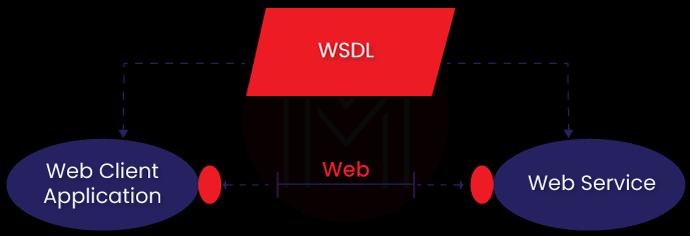
| Related Article: What is WSDL in Web Services |
13. Write the difference between API and Web Services.
- API (Application Programming Interface): It serves as a bridge between two devices, allowing them to communicate without the need for user intervention. Some of its benefits are customisable, easy GUI integration, time-effective, language-independent, and so on. APIs aren't all the same as web services.
- Web Service: It enables two devices to communicate via a network. They're commonly used to transfer data across systems or applications. Loosely connected, it facilitates document exchange, interoperability, extensibility, and some of its properties. APIs are the building blocks of all Web services.
| API | Web Service |
| It can be done both online and offline | It requires the utilisation of a network. |
| They're made of light materials. | They are not lightweight architectures because they use SOAP to send and receive network data |
| It can be designed in any style or protocol. | It can only use SOAP, although it can also use UDDI, XML, RPC, and REST occasionally. |
|
It is compatible with HTTP/HTTPS protocols and XML and JSON. | It supports the HTTP protocol as well as XML. |
| It does not require the use of a network to function. |
Its functionality necessitates the use of a network. |
| They're free and open-source, used to create XML documents. | They're not open source, but they're helpful for essentialising deciphering JSON (JavaScript Object Notation). |
14. What is XML-RPC?
The most basic and straightforward XML-based protocol for exchanging data across multiple devices on a network is XML-RPC (Remote procedure call). It employs HTTP as a transport protocol to quickly and conveniently deliver information or data between two devices. Perl, Java, Python, C, C++, PHP, and more programming languages can all be used with XML-RPC.
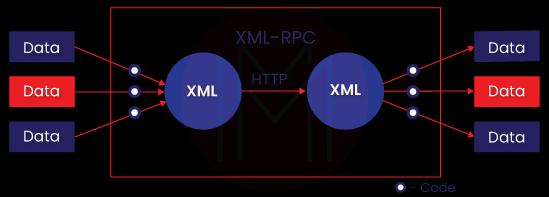
Web Services Scenario-Based Interview Questions
15. What are the features of XML-RPC?
The following are some of the features of XML-RPC:
- Independent of the platform
- Allows several applications to communicate with one another.
- It's thought to be the most straightforward approach to get started with online services.
- The calls are encoded in XML, and the transport protocol is HTTP.
16. What do you mean by UDDI?
UDDI (Universal Description, Discovery, and Integration) is a web service directory that allows you to describe, publish, and find web services. It can also be used to make business registers. Among other web standards, it is based on HTTP, XML, SOAP, WSDL, and XML Schema. Its primary purpose is to improve the efficiency of digital transactions and e-commerce between company systems.

17. What are the essential features of UDDI?
The following are some of UDDI's key features:
- Platform agnostic; uses WSDL to describe web service interfaces.
- SOAP, Java RMI, and CORBA Protocol are all options for communication.
- The distinction between the interface and the implementation is important.
- In terms of protocols, it's neutral.
18. Explain Web Service Architecture.
Every framework, including web services, requires some form of architecture to ensure that the entire framework functions as intended. Web service architecture is used to help the developer with the stages and procedures required to finish the project. Service provider, service requester, and service registry are three separate responsibilities in web service architecture. It also contains three different operations, which are as follows:
- Publish (Publication of Service Descriptions): A service description must be made public so that the service requestor can find it and use it. It can be published anywhere, based on the application's requirements.
- Find (Finding of Services Descriptions): A service requestor can get a service description directly from the provider. The requestor consults the broker to find a previously published web service.
- Bind (Invoking of Service based on Service Description): Each service must be activated. The service requestor uses binding details in the service description to identify, contact, and invoke the service.
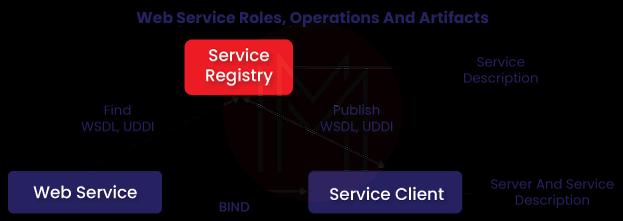
19. What is RESTful Web Services?
REST (Representational State Transfer) is a stateless, client-server architecture approach used to create web-based applications. It's a type of online service whose primary objective is to improve the efficiency of other web services. It can be defined as a web service that implements the REST architecture using HTTP methods. Restful services are structurally based, unlike SOAP, which is protocol-based. There is no contract or WSDL file in it.
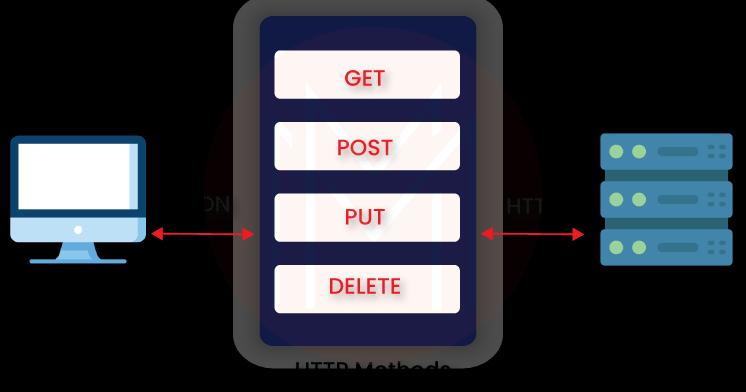
20. Explain different HTTP methods supported by RESTful web services?
RESTful web services support several standard HTTP methods and their functions described below.
- GET: The resource is only accessible in read-only mode.
- PUT: New resource creation.
- DELETE: A resource is deleted.
- POST: This is a method of updating an existing resource.
- OPTIONS: Get the resource's supported operations.
- HEAD: Only returns HTTP headers, no one else.
If you're an experienced pro in this field looking to progress your career, here are some web service interview questions to prepare for.
21. What are the advantages of RESTful web services?
RESTful web services have several advantages, which are listed below:
- Independent of the platform.
- It's simple to implement and test.
- JSON, XML, HTML, and more formats are supported.
- It can be developed in various computer languages and run on a variety of platforms.
- It's small, manageable, scalable, and re-usable.
- Faster, more efficient, and more effective.
- Reduce the amount of bandwidth and resources used.
- There are numerous automation frameworks available.
22. What is the difference between SOAP and REST web services?
| SOAP | REST |
| SOAP is a protocol | REST is a style of architecture. |
| SOAP stands for Simple Object Access Protocol. | REST stands for Representational State Transfer. |
| Since SOAP is a protocol, it cannot use REST. | Since REST is a concept that can use any protocol, such as HTTP or SOAP, it can use SOAP web services |
| SOAP exposes business logic through services interfaces. | REST exposes business logic through URIs. |
| SOAP establishes guidelines that must be followed to the letter. | REST doesn't have as many standards as SOAP. |
| Only the XML data format is supported by SOAP. | REST supports various data formats, including plain text, HTML, XML, and JSON. |
Web Services Interview Questions for Experienced
23. What are the different layers of the web service protocol stack?
Web service deployment is typically based on technologies arranged in a layered stack. The second technique for viewing the web service architecture is to examine the web service protocol stack. In layman's terms, it's a set of protocols for exploring and executing online services. The web service protocol stack currently has four tiers, as shown below:
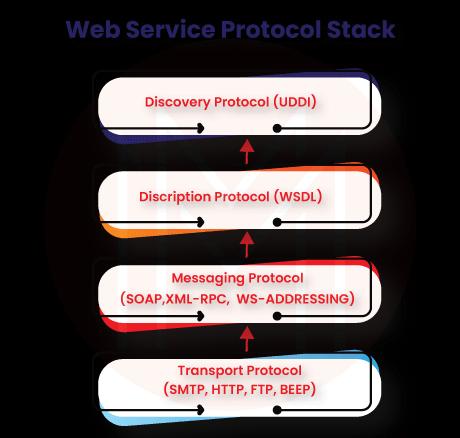
- Service Transport: It is in charge of transporting communications across programmes in general. It essentially establishes communication technology standards and allows messages or information to flow freely across a network. The HTTP, SMTP, FTP, and DEEP protocols transfer data.
- XML Messaging: It is generally in charge of encoding messages into XML format so that they may be understood on both ends. XML-RPC and SOAP are typical examples of this layer.
- Service Description: It is generally responsible for describing a public web interface. WSDL is a standard format for describing services.
- Service Discovery: It is primarily responsible for centralising services into a single registry and facilitating the publishing and discovery of online services. UDDI is commonly used for service discovery.
24. Explain the term statelessness concerning RESTful web Services. Write its advantages.
According to the REST design, RESTful web services cannot store a client state on the server, which is known as statelessness. It is the client's responsibility to provide the server with their context. The server then stores this context to process the client's request.
Advantages
- There's no need to keep track of earlier client encounters.
- Each method request is given its treatment.
- Application design is more straightforward and less complex.
Example: Simple GET Request using NodeJS
In the users.json file, we have the following sample data.
Filename: users.json
{
"user1" : {
"name" : "gourav",
"password" : "password1",
"profession" : "officer",
"id": 1
},
"user2" : {
"name" : "nikhil",
"password" : "password2",
"profession" : "teacher",
"id": 2
}
}Use the following code in a server.js file to implement our RESTful API listeners.
Filename: server.js
// Requiring module
var express = require('express');
var app = express();
var fs = require("fs");
// Sample GET API
app.get('/listUsers', function (req, res) {
fs.readFile( __dirname + "/" + "users.json", 'utf8', function (err, data) {
console.log( data );
res.end( data );
});
})
// Server setup
var server = app.listen(8081, function () {
var host = server.address().address
var port = server.address().port
console.log("Example app listening at http://%s:%s", host, port)
})Now open a browser and go to http://127.0.0.1:8081/listUsers; we will get the following response:
{
"user1" : {
"name" : "gourav",
"password" : "password1",
"profession" : "officer",
"id": 1
},
"user2" : {
"name" : "nikhil",
"password" : "password2",
"profession" : "teacher",
"id": 2
}
}25. What are the different elements of the SOAP Document or message?
The SOAP message is essentially an XML document with three sections, as seen below:
- SOAP Envelope: It is required to mark XML documents as SOAP messages. It merely establishes the beginning and conclusion of the communication.
- SOAP Header: It's a non-required element that contains header data.
- SOAP Body: It is a required element that contains information about calls and responses. It contains XML data that includes essential web services intended to develop and deploy message sent.
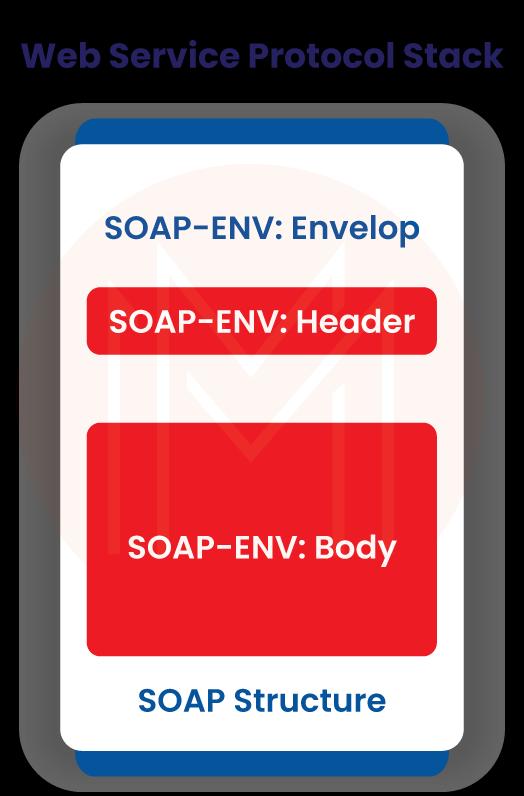
The general structure of a SOAP XML request and response is shown in the block below:
XML Request
<Envelope xmlns=?http://schemas.xmlsoap.org/soap/envelop/?>
<Body>
<getCourseDetailRequest xmlns=?http://udemy.com/course?>
<id>course1</id>
<getCourseDetailRequest>
</Body>
</Envelope>XML Response
<SOAP-ENV:Envelope xmlns:SOAP-ENV=?http://schemas.xmlsoap.org/soap/envelope/?>
<SOAP-ENV:Header /> <!?empty header-->
<SOAP-ENV:Body> <!?body begin-->
<ns2:getCourseDetailsResponse xmlns:ns2=?http://in28mi> <!--content of the response-->
<ns2:course>
<ns2:id>Course1</ns2:id>
<ns2:name>Spring<ns2:name>
<ns2:description>10 Steps</ns1:description>
</ns2:course>
</ns2:getCourseDetailResponse>
</SOAP-ENV:Body> <!?body end-->
</SOAP-ENV:Envelope>26. What do you mean by Java Web services? Name the methods to create web services.
Java web services are messages intended to develop and deploy essential web services on the Java platform. Java web service applications communicate using WSDL, and they may be accessible using a variety of computer languages, including.Net, PHP, and others. SOAP and RESTful are two methods for writing java web application code.

27. Name some essential deploy annotations of JAX-WS.
The following are the most important JAX-WS annotations:
- @WebService
- @WebMethod
- @SOAPBinding
- @WebResult
- @WebServiceClient
28. What is JAXB? Name three different packages in JAXB binding framework.
JAXB (Java Architecture for XML Binding) is a Java standard that specifies how Java objects are translated to and from XML. The reading and writing of XML are much easier using Java. It allows Java applications to read XML documents more easily. There are three different packages available in the JAXB binding framework:
- xml.bind
- xml.bind.util
- xml.bind.helper
29. What’s the difference between Web services and CORBA or DCOM?
| Web Service | CORBA and DCOM |
| Web services use the HTTP protocol to send and receive messages to and from applications. A web service uses XML to encode data. | They primarily use non-standard protocols like RPC, IIOP (Inter Internet Object Protocol), and others to send and receive messages to and from applications. |
| Web services are defined using the WSDL format. | CORBA components are described using the CORBA Interface Description Language, while DCOM components are described using the Microsoft Interface Definition Language. |
| Web services are discovered using UDDI. | CORBA components are defined in the CORBA registry, while DCOM components are describeddefinedUsing programmatic interfaces in the DCOM registry. |
| They work well with firewalls. |
CORBA employs the IIOP protocol, which is not compatible with the internet. |
30. What are .NET Web services and .NET Remoting? Write the difference between them.
- .NET Web service: It's a way for cross-platform integration that uses XML, HTTP, and SOAP for communication between two devices via the internet. It simply distributes business logic, processes, and data across a network using programmatic interfaces.
- .NET Remoting: It's a technique for allowing objects to communicate or interact with one another across application domains, processes, and machine boundaries, regardless of whether the application components are on the same computer or machines all over the world.
Both are powerful technologies that give appropriate frameworks and help construct distributed technologies and application integration. As shown below, there are some differences between these two technologies.
| Web Services | NET Remoting |
| It makes use of the HTTP protocol. | The TCP/HTTP/SMTP protocol is used. |
| When compared to.NET Remoting, its performance is slow. | Using the TCP channel with the binary format allows faster communication and performance. |
| These services are more stable because they are hosted on IIS. | When compared to.NET Web services, it is less reliable. |
| It supports the XML Schema type system and has a fundamental programming style with cross-platform compatibility. | It has a runtime system and a complicated programming paradigm but a relatively restricted reach. |
Conclusion
We are at the end of the blog, and the above given are the frequently asked Web Services Interview Questions asked in various MNC companies. If you feel any other questions to be added apart from the above questions, feel free to suggest the question in the comment section, Our experts will update the proposed question with clear and concise answers as soon as possible. Best of luck with your interview!
 On-Job Support Service
On-Job Support Service
Online Work Support for your on-job roles.

Our work-support plans provide precise options as per your project tasks. Whether you are a newbie or an experienced professional seeking assistance in completing project tasks, we are here with the following plans to meet your custom needs:
- Pay Per Hour
- Pay Per Week
- Monthly
| Name | Dates | |
|---|---|---|
| SoapUI Training | Jan 10 to Jan 25 | View Details |
| SoapUI Training | Jan 13 to Jan 28 | View Details |
| SoapUI Training | Jan 17 to Feb 01 | View Details |
| SoapUI Training | Jan 20 to Feb 04 | View Details |

Madhuri is a Senior Content Creator at MindMajix. She has written about a range of different topics on various technologies, which include, Splunk, Tensorflow, Selenium, and CEH. She spends most of her time researching on technology, and startups. Connect with her via LinkedIn and Twitter .
















